The Bubble Nebula is an emission nebula located 7,100 – 11,000 light-years away in the northern constellation Cassiopeia. With an apparent magnitude of 10, it can be observed in medium and larger telescopes. The H II region appears close to the bright open cluster Messier 52 in the sky. It has the designation NGC 7635 in the New General Catalogue, and is listed as Caldwell 11 in the Caldwell catalogue and Sharpless 162 (Sh2-162) in the Sharpless catalogue of H II regions.
NGC 7635 was nicknamed the Bubble Nebula because of its shape. It appears like a slightly elongated bubble suspended in space. The bubble was created by the strong stellar wind of a hot, massive star that is rapidly losing mass in the final stages of its life. As the stellar wind meets the interstellar material of the nearby giant molecular cloud at supersonic speeds, it produces a shock front, shaping the bubble. The giant molecular cloud contains the nebula’s expansion and is itself lit by the nebula’s luminous central star.
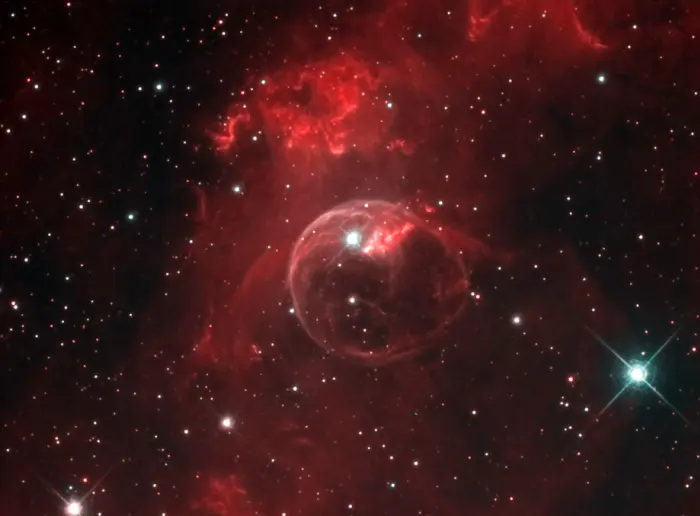
The Bubble Nebula (NGC 7635), image credit: Robert J. Vanderbei (CC BY 3.0)
The Bubble Nebula has an estimated age of about 40,000 years. It expands at 36 km/s-1. The asymmetry in the nebula’s spherical shape is due to the inhomogeneous nature of the interstellar medium into which the nebula is expanding. The central bubble is about 6 – 10 light-years across.
The strong stellar wind comes from the gas in the outer atmosphere of the star, which gets so hot that it escapes into interstellar space. The wind moves at speeds of over 4 million miles per hour, sweeping up the gas it encounters and forming the outer edge of the Bubble Nebula.
The expansion of the Bubble Nebula is contained by the denser, higher-pressure regions on one side of the nebula. For this reason, the nebula’s central star appears off-centre in the bubble. As the stellar wind collides with such variations in the interstellar gas, it creates the rippled appearance of the bubble.
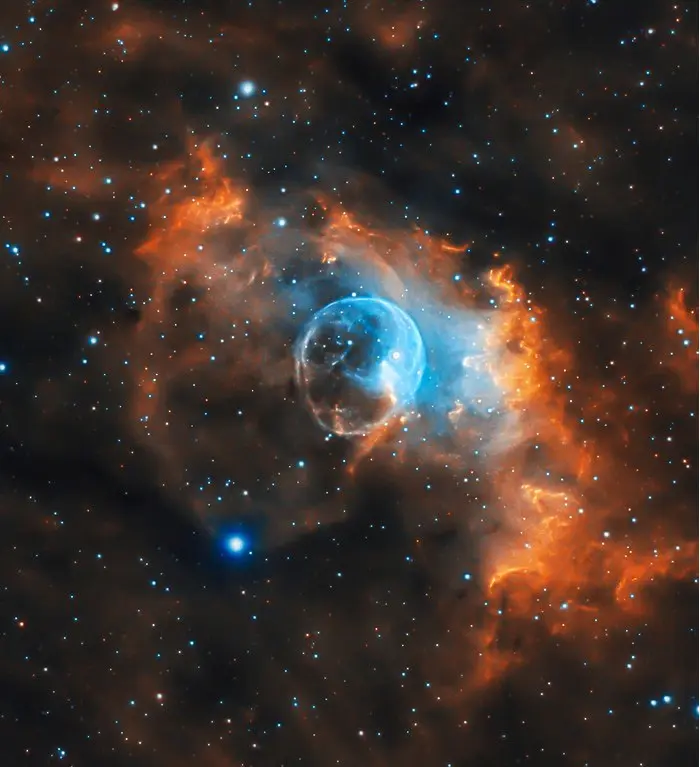
The image of the Bubble Nebula was created using Ha, OIII, and SII filters. I put SII in the “Red Channel”, Ha in the “Green Channel”, and OIII in the “Blue Channel”. Image credit: Chuck Ayoub (CC BY-SA 4.0)
Central star
The hot central star of the Bubble Nebula is catalogued as SAO 20575 (BD+60°2522). It is a hot star of the spectral type O6.5(n)fp. It shines at magnitude 8.67, well below unaided eye visibility. The spectrum of SAO 20575 shows peculiarities that make the star’s exact stellar class difficult to determine.
However, SAO 20575 is beyond any doubt an exceptionally massive and luminous star. Some sources suggest that it is a Wolf-Rayet star, an even rarer luminous object with more powerful stellar winds.
With a mass 44 times that of the Sun, SAO 20575 is a supernova candidate. It has already lost a lot of its initial mass through a powerful stellar wind. The estimated speed of the star’s stellar wind is 1,800 – 2,500 km/s.
Astronomers believe that the star had an initial mass of about 60 solar masses, and it has already lost a quarter of it through the stellar wind. The star has lost most of its outer hydrogen and is currently fusing helium into heavier elements.
SAO 20575 has 15 times the Sun’s radius and shines with a luminosity of 398,000 Suns. It has an effective temperature of 37,500 K and spins at 178-240 km/s.
The hot star lies approximately 9,800 light-years away in the Perseus Arm of the Milky Way. It is a member of the Cassiopeia OB2 association. It has an estimated age of only 2 million years. Even though it is still a young star, SAO 20575 will not live a very long life because of its high mass.
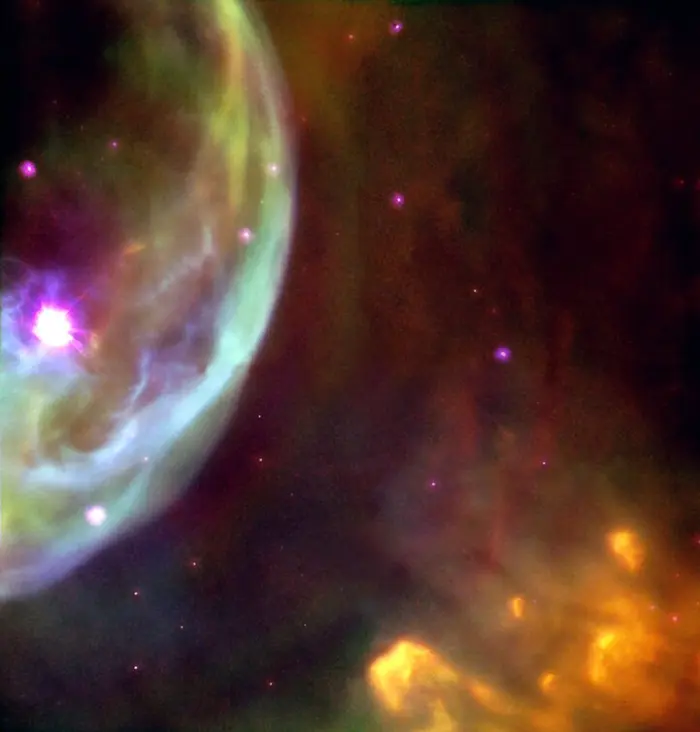
Hubble captured this image of Caldwell 11’s central star and one edge of the nebula’s “bubble” with the telescope’s original Wide Field and Planetary Camera in 1992. Image credit: The Hubble Heritage Team (AURA/STScI/NASA) (CC BY 2.0)
Facts
The Bubble Nebula was discovered by the German-born British astronomer William Herschel on November 3, 1787. Herschel listed the nebula as IV 52 in his catalogue and described it as “a star 9 magnitude with very faint nebulosity of small extent about it.”
His son John Herschel observed the nebula on September 30, 1829. The nebula was listed as GC 4947 in his General Catalogue of Nebulae and Clusters of Stars (GC).
Danish astronomer John Louis Emil Dreyer listed the nebula as NGC 7635 in the New General Catalogue.
The Bubble Nebula (NGC 7635) is not to be confused with the Bubble Nebula (Hubble 1925 I), an emission nebula located within Barnard’s Galaxy (NGGC 6822) in the constellation Sagittarius, nor with the Soap Bubble Nebula (PN G75.5+1.7), a planetary nebula in Cygnus. All three nebulae appear roughly spherical but lie in different regions of the sky.
The Bubble Nebula was imaged with different instruments aboard NASA’s Hubble Space Telescope on several occasions. It was captured by the Wide Field Planetary Camera (WFPC) in September 1992, and with the Wide Field Planetary Camera 2 (WFPC2) in April 1999.
In 2016, NASA released an image of the enormous bubble to mark the 26th anniversary of Hubble’s launch. The image was taken with Hubble’s Wide Field Camera 3 in visible light in February 2016.
The Hubble images reveal dense pillars of cool hydrogen gas with superimposed dust, as well as fingers of gas that appear behind the transparent bubble. The pillars resemble the famous Pillars of Creation region located in the Eagle Nebula (Messier 16). Like the pillars in the Eagle Nebula, those in the Bubble Nebula are lit by the strong ultraviolet radiation of the hot, luminous, young central star.
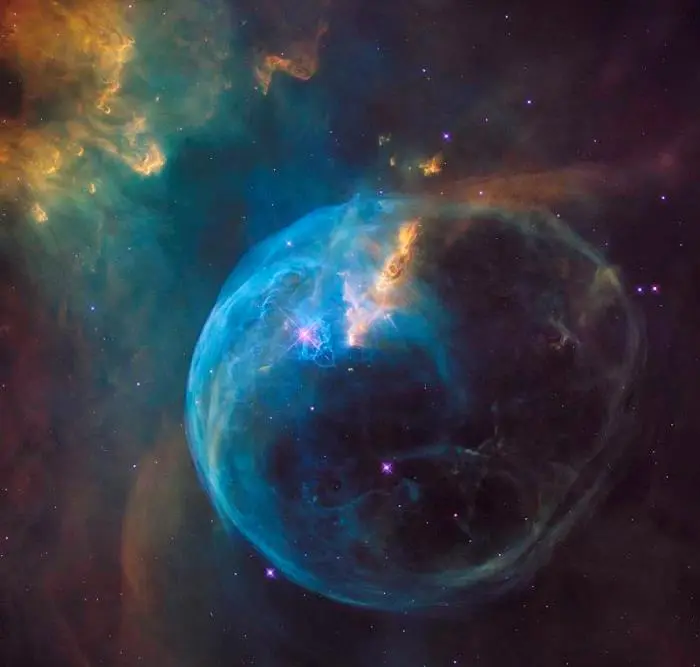
For the 26th birthday of NASA’s Hubble Space Telescope, astronomers are highlighting a Hubble image of an enormous bubble being blown into space by a super-hot, massive star. The Hubble image of the Bubble Nebula, or NGC 7635, was chosen to mark the 26th anniversary of the launch of Hubble into Earth orbit by the STS-31 space shuttle crew on April 24, 1990. The seething star forming this nebula is 45 times more massive than our sun. Gas on the star gets so hot that it escapes away into space as a “stellar wind” moving at over four million miles per hour. This outflow sweeps up the cold, interstellar gas in front of it, forming the outer edge of the bubble much like a snowplow piles up snow in front of it as it moves forward. As the surface of the bubble’s shell expands outward, it slams into dense regions of cold gas on one side of the bubble. This asymmetry makes the star appear dramatically off-center from the bubble, with its location in the 10 o’clock position in the Hubble view. Dense pillars of cool hydrogen gas laced with dust appear at the upper left of the picture, and more “fingers” can be seen nearly face-on, behind the translucent bubble. Hubble’s Wide Field Camera-3 imaged the nebula in visible light with unprecedented clarity in February 2016. The colors correspond to blue for oxygen, green for hydrogen, and red for nitrogen. This information will help astronomers understand the geometry and dynamics of this complex system. Image credit: NASA, ESA, and the Hubble Heritage Team (STScI/AURA) (CC BY 2.0)
Location
The Bubble Nebula lies in the constellation Cassiopeia, near the border with Cepheus. It appears on the imaginary line extended from Caph in Cassiopeia to Alderamin in Cepheus, about a third of way from Caph to Cepheus’ brightest star.
The Bubble Nebula appears in the direction of the open cluster Messier 52. The two objects are not related. The cluster is much closer to us, at a distance of 4,600 light-years. The nebula and the cluster are popular targets for astrophotographers because they can be captured in the same wide field of view.
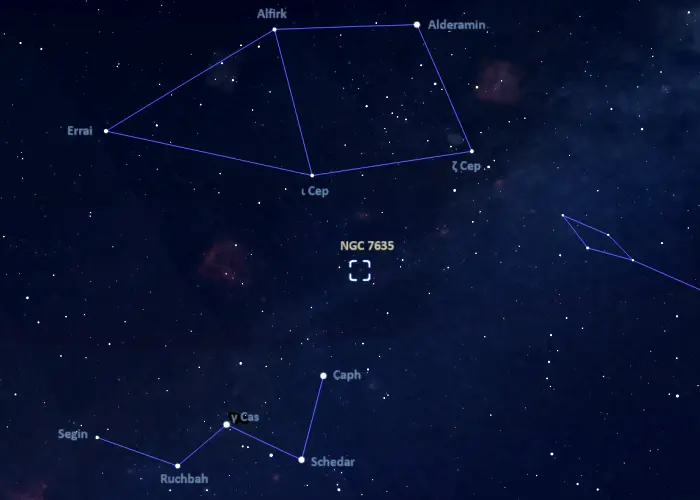
The location of the Bubble Nebula (NGC 7635), image: Stellarium
Messier 52 appears about a third of the way from Caph to Alderamin, and the nebula appears only 0.5 degrees southwest of the cluster.
Alderamin can be identified by drawing a line from Schedar through Caph in Cassiopeia’s W. The giant star appears at the base of an asterism that looks like a stick house and is the brightest star in this region of the sky.
The Bubble Nebula is a difficult target for small telescopes because it has a low surface brightness. It can be seen in 6-inch and larger telescopes in good conditions. In an 8 or 10-inch telescope, the nebula appears as a faint shell around SAO 20575. The nebula’s irregular shape can be seen in 16 or 18-inch telescopes. The nebula is best seen using filters and averted vision.
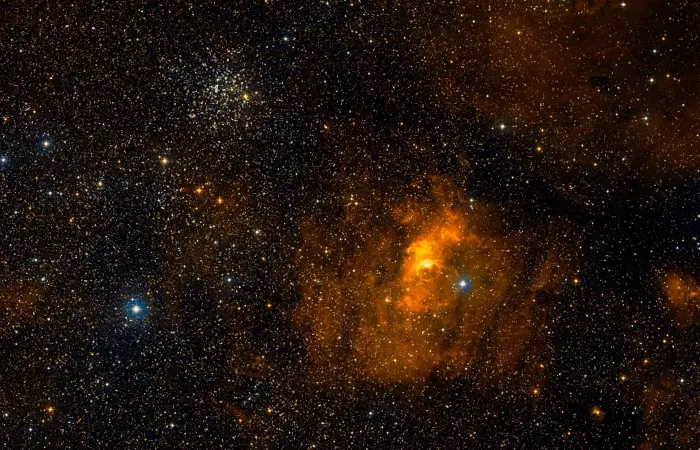
The Bubble Nebula and Messier 52, image: Wikisky (DSS)
The Bubble Nebula and Messier 52 appear in a region with several other nebulae and star clusters. These include the large emission nebula Sh2-157, popularly known as the Lobster Claw Nebula, the star-forming region NGC 7538, nicknamed the Northern Lagoon, and the open cluster NGC 7510, also known as the Dormouse Cluster or the Arrowhead Cluster. Another large HII region, Sh2-161, also lies in the vicinity.
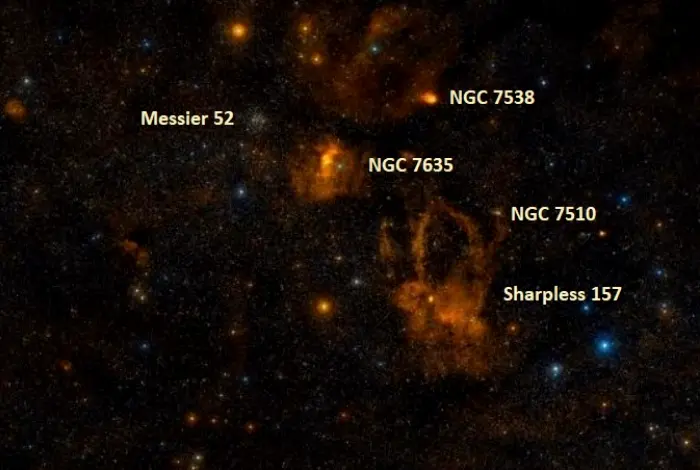
The Bubble Nebula, Messier 52, NGC 7538, Sh2-157 and NGC 7510, image: Wikisky (DSS)
At declination 61°, the Bubble Nebula is visible from locations north of the latitude 28° S. It never rises very high above the horizon for southern hemisphere observers in equatorial latitudes.
For observers in the northern hemisphere, the nebula is visible throughout the year from locations north of the latitude 28° N. The best time of the year to observe it is during the month of November, when Cassiopeia is high above the horizon in the evening.
Bubble Nebula – NGC 7635
| Constellation | Cassiopeia |
| Right ascension | 23h 20m 48.3s |
| Declination | +61° 12′ 06″ |
| Apparent magnitude | 10 |
| Apparent size | 15’ x 8’ |
| Distance | 7,100 – 11,000 light-years (3,400 parsecs) |
| Radius | 3 – 5 light-years |
| Names and designations | Bubble Nebula, NGC 7635, Caldwell 11, Sharpless 162 (Sh2-162), LBN 548 |
Images
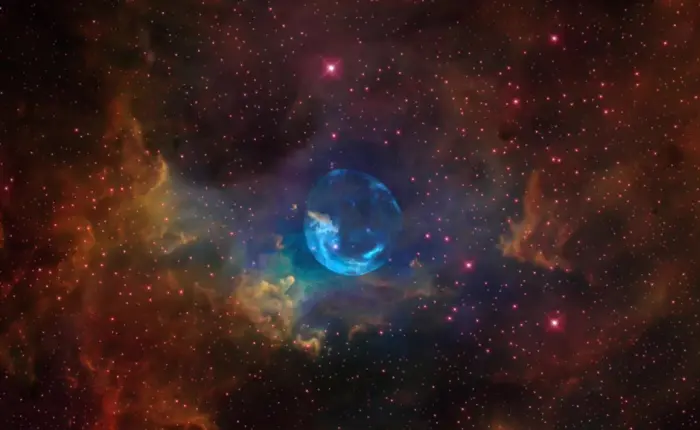
The Bubble Nebula by the Hubble Space Telescope (HST). Image credit: NASA, ESA, and the Hubble Heritage Team (STScI/AURA) (CC BY 2.0)
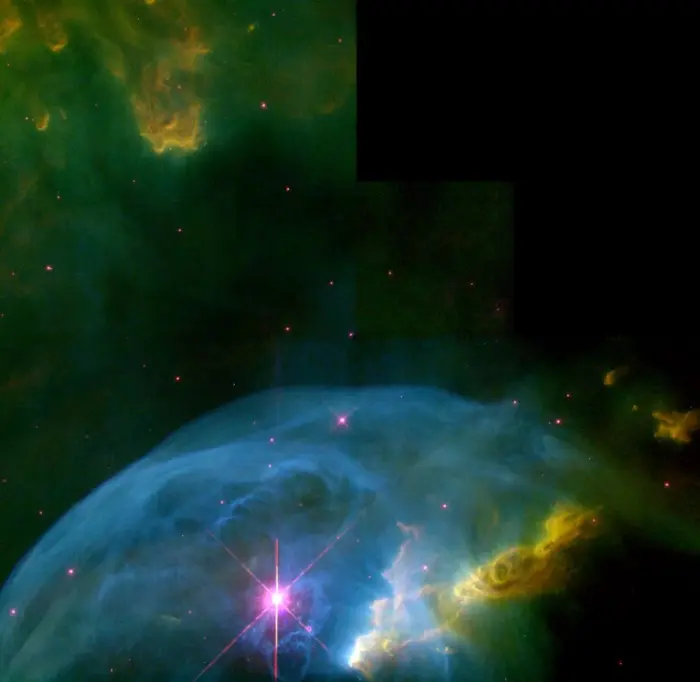
Astronomers, using the Wide Field Planetary Camera 2 on board NASA’s Hubble Space Telescope in October and November 1997 and April 1999, imaged the Bubble Nebula (NGC 7635) with unprecedented clarity. Image credit: NASA, Donald Walter (South Carolina State University), Paul Scowen and Brian Moore (Arizona State University); Research Team: Donald Walter (South Carolina State University), Paul Scowen, Jeff Hester, Brian Moore (Arizona State University), Reggie Dufour, Patrick Hartigan and Brent Buckalew (Rice University)
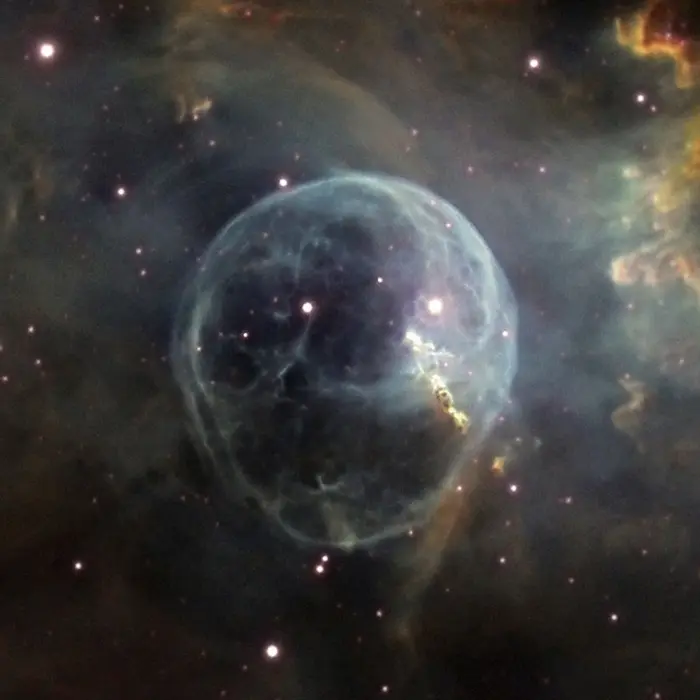
Bubble Nebula (Caldwell 11), image credit: Giuseppe Donatiello (CC0 1.0)
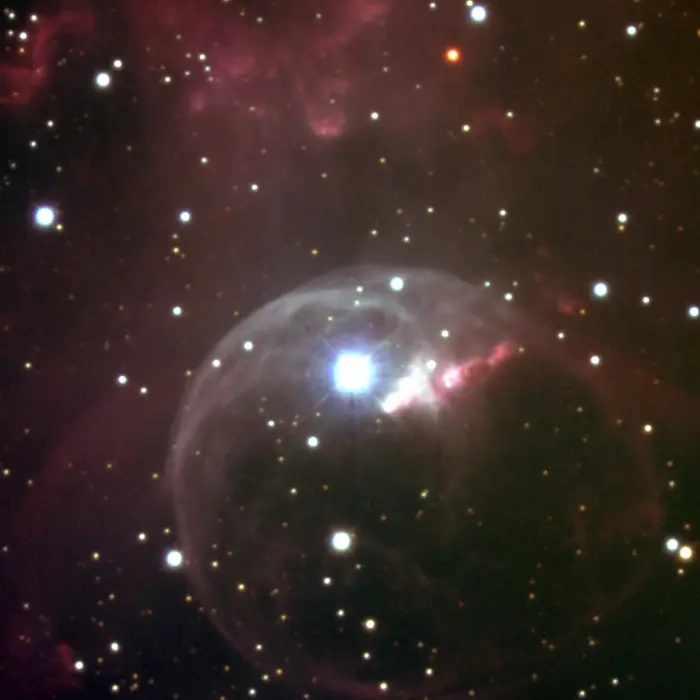
The Bubble Nebula is a shell of gas and dust carved out by the stellar wind of the massive central star (BD+602522, for the cognoscenti), and ionized by the same star’s high-energy light. The Bubble Nebula is in the constellation Cassiopeia, and is bright enough to be seen with a small telescope. It is about 10 light-years across, and is part of a much larger complex of stars and gaseous shells. This picture was created from several exposures in each of three filters made with the T1KA CCD camera at the Kitt Peak National Observatory’s 2.1-meter telescope in August of 1999. Image credit: Doug Williams NOIRLab/NSF/AURA (CC BY 4.0)
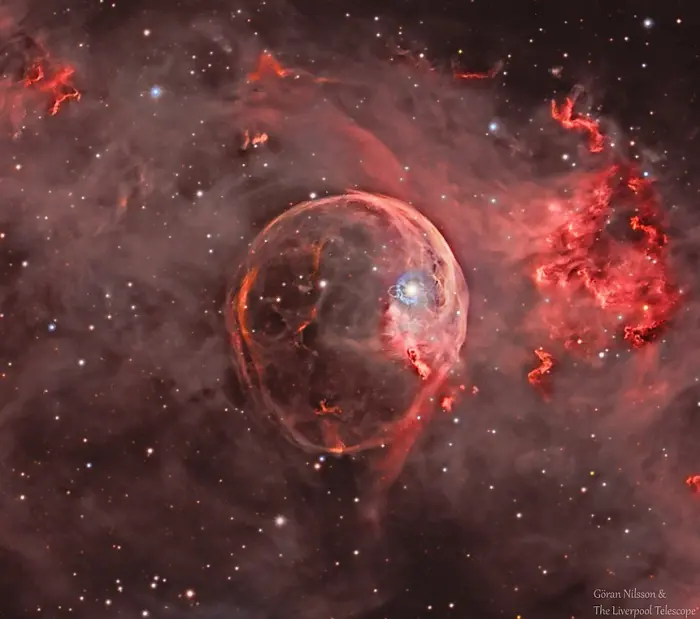
HaRGB image of the Bubble Nebula NGC 7635. Data from the Liverpool Telescope, a 2 m RC telescope on La Palma. Processed by Göran Nilsson. Image credit: Göran Nilsson & The Liverpool Telescope (CC BY-SA 4.0)
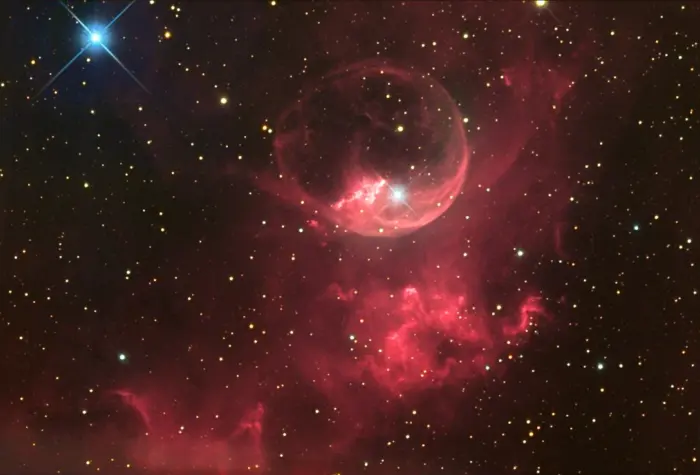
This mysterious ball of gas is about half a degree from M52, in Cassiopeia. See NGC 2359-Thor’s Helmet for more information on this type of object.This image was taken as part of Advanced Observing Program (AOP) program at Kitt Peak Visitor Center during 2014. Image credit: KPNO/NOIRLab/NSF/AURA/Brad Ehrhorn/Adam Block (CC BY 4.0)
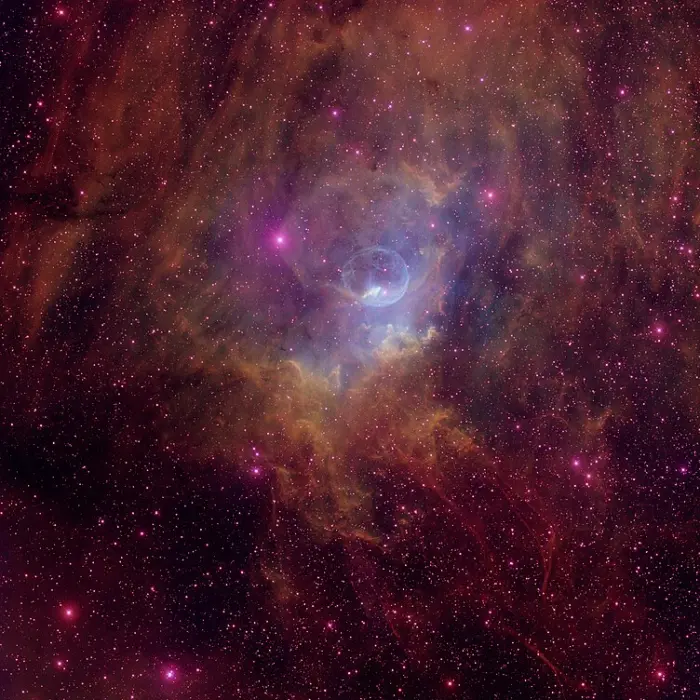
The Bubble Nebula (NGC7635) is one of three shells of gas surrounding the massive star BD+602522, the bright star near the center of the bubble. Energetic radiation from the star ionizes the shell, causing it to glow. About six light-years in diameter, the Bubble Nebula is located in the direction of the constellation Cassiopeia. The magenta wisps near the bottom-right of the image are an unexpected bonus—the wisps are the remnants of a supernova that exploded thousands of years ago. This is the first optical image of the supernova remnant, which was discovered at radio wavelengths by the Canadian Galactic Plane Survey in 2005. Image credit: T.A. Rector/University of Alaska Anchorage, H. Schweiker/WIYN and NOIRLab/NSF/AURA (CC BY 4.0)
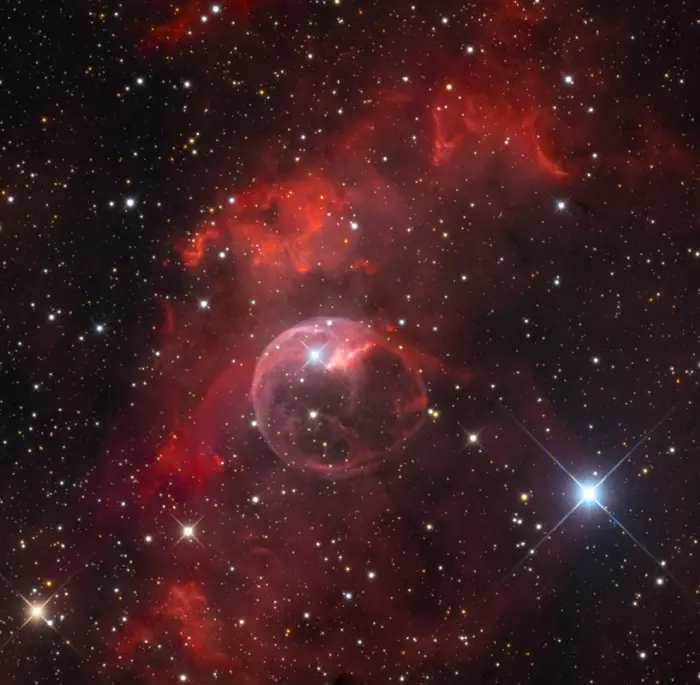
The Bubble Nebula (NGC 7635), image credit: Adam Block/Mount Lemmon SkyCenter/University of Arizona (CC BY-SA 4.0)
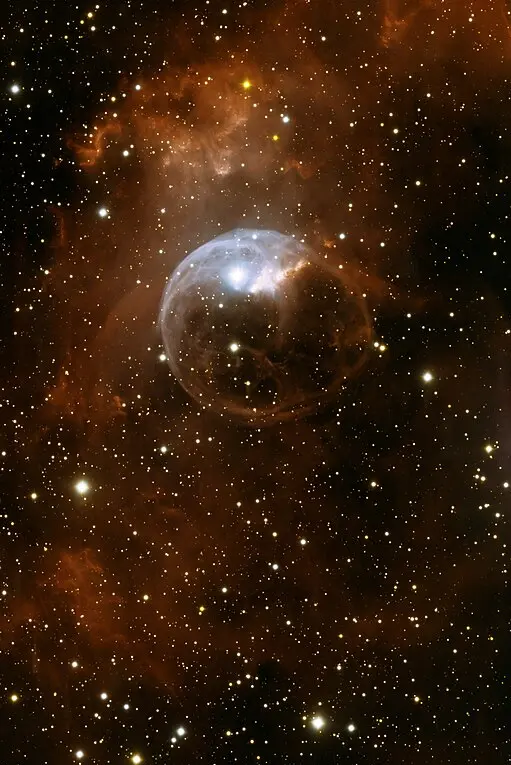
This central, cosmetically corrected view of NGC 7635 shows the nebulosity carved out by the winds of the massive central star and demonstrates the exquisite image quality of the One Degree Imager camera on the WIYN 3.5-m telescope. Image credit: T.A. Rector (University of Alaska Anchorage), WIYN ODI team & WIYN/NOIRLab/NSF/AURA (CC BY 4.0)